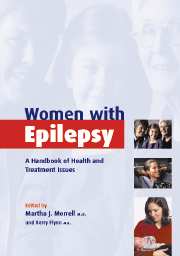Book contents
- Frontmatter
- Contents
- List of contributors
- Part I The woman with epilepsy
- Part II Epilepsy diagnosis and treatment
- 5 The genetics of epilepsy
- 6 Epilepsy: epidemiology, definitions, and diagnostic procedures
- 7 Antiepileptic drugs and other treatments for epilepsy
- 8 Epilepsy in children and adolescents
- 9 Nonepileptic seizures
- Part III Hormones and the brain
- Part IV Health challenges for women with epilepsy
- Part V Family planning, pregnancy, and parenting
- Part VI Living well with epilepsy
- Appendix: The Epilepsy Foundation's Campaign for Women's Health: bringing help and hope to women with epilepsy
- Index
- References
8 - Epilepsy in children and adolescents
from Part II - Epilepsy diagnosis and treatment
Published online by Cambridge University Press: 02 November 2009
- Frontmatter
- Contents
- List of contributors
- Part I The woman with epilepsy
- Part II Epilepsy diagnosis and treatment
- 5 The genetics of epilepsy
- 6 Epilepsy: epidemiology, definitions, and diagnostic procedures
- 7 Antiepileptic drugs and other treatments for epilepsy
- 8 Epilepsy in children and adolescents
- 9 Nonepileptic seizures
- Part III Hormones and the brain
- Part IV Health challenges for women with epilepsy
- Part V Family planning, pregnancy, and parenting
- Part VI Living well with epilepsy
- Appendix: The Epilepsy Foundation's Campaign for Women's Health: bringing help and hope to women with epilepsy
- Index
- References
Summary
Dr Patricia Crumrine is Professor of Pediatric Neurology at the University of Pittsburgh. She is a specialist in childhood epilepsy and a former member of the Epilepsy Foundation's Professional Advisory Board.
In this chapter she deals with epilepsy in girls and young women, reviewing the common epilepsy syndromes, treatment challenges, and educational and social concerns.
MJMSeizures
Approximately 3.5% of all children will have experienced at least one seizure by the age of 15 years. However, only about 1% of children will develop epilepsy or recurrent seizures. Epilepsy arises most frequently during the first year of life. Its incidence (how many people develop the condition) remains high throughout childhood and adolescence and is higher in boys than in girls under the age of 10. Over the age of 10 years, there is not a significant difference between the frequency of development of epilepsy in boys and girls.
The cause of epilepsy is identifiable in only about 24% of childhood cases and is usually developmental. The medical evaluation may include an analysis of the blood cell count, hemoglobin, sugar, calcium, sodium, potassium, as well as other blood tests. The physician may also order an electroencephalogram (EEG), which is a test recording the electrical activity of brain cells. This test may predict the potential of having another seizure. Another possible test is a brain image, usually a magnetic resonance image (MRI) scan.
Keywords
- Type
- Chapter
- Information
- Women with EpilepsyA Handbook of Health and Treatment Issues, pp. 77 - 88Publisher: Cambridge University PressPrint publication year: 2003

